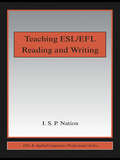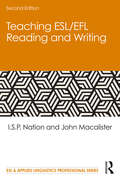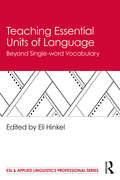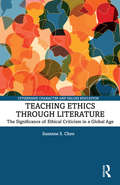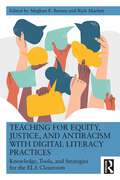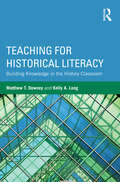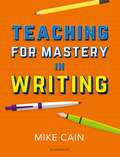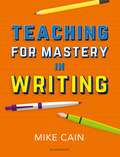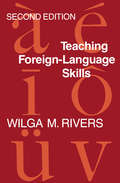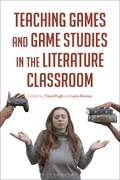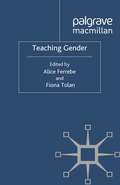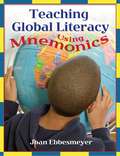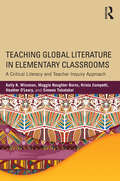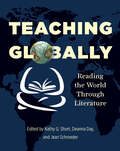- Table View
- List View
Teaching ESL/EFL Reading and Writing (ESL & Applied Linguistics Professional Series)
by I.S.P. NationUsing a framework based on principles of teaching and learning, this guide for teachers and teacher trainees provides a wealth of suggestions for helping learners at all levels of proficiency develop their reading and writing skills and fluency. By following these suggestions, which are organized around four strands – meaning-focused input, meaning-focused output, language-focused learning, and fluency development – teachers will be able to design and present a balanced program for their students. Teaching ESL/EFL Reading and Writing, and its companion text, Teaching ESL/EFL Listening and Speaking, are similar in format and the kinds of topics covered, but do not need to be used together. Drawing on research and theory in applied linguistics, their focus is strongly hands-on, featuring easily applied principles, a large number of useful teaching techniques, and guidelines for testing and monitoring, All Certificate, Diploma, Masters and Doctoral courses for teachers of English as a second or foreign language include a teaching methods component. The texts are designed for and have been field tested in such programs.
Teaching ESL/EFL Reading and Writing (ESL & Applied Linguistics Professional Series)
by I.S.P. Nation John MacalisterThe second edition of this bestselling text, Teaching ESL/EFL Reading and Writing, is a fully updated and expanded guide for teaching learners at all levels of proficiency how to develop their reading and writing skills and fluency. Practical and accessible, this book covers a diverse array of language teaching techniques suitable for all contexts. Updated with cutting-edge research and theory, the second edition is an essential and engaging text. Key insights and suggestions are organised around four strands – meaning-focused input, meaning-focused output, language-focused learning, and fluency development – to allow teachers to design and present a balanced programme for their students. Bringing together research and theory in applied linguistics and education, the text includes useful examples and practical strategies and features new topics related to technology, assessment, and genre. The second edition includes new tasks and further reading sections in every chapter. Teaching ESL/EFL Reading and Writing is designed for practising and pre-service teachers of all levels, and is ideal for certificate, diploma, masters, and doctoral courses in English as a second or foreign language.
Teaching ESL/EFL Reading and Writing (ESL & Applied Linguistics Professional Series)
by I.S.P. Nation John MacalisterThe second edition of this bestselling text, Teaching ESL/EFL Reading and Writing, is a fully updated and expanded guide for teaching learners at all levels of proficiency how to develop their reading and writing skills and fluency. Practical and accessible, this book covers a diverse array of language teaching techniques suitable for all contexts. Updated with cutting-edge research and theory, the second edition is an essential and engaging text. Key insights and suggestions are organised around four strands – meaning-focused input, meaning-focused output, language-focused learning, and fluency development – to allow teachers to design and present a balanced programme for their students. Bringing together research and theory in applied linguistics and education, the text includes useful examples and practical strategies and features new topics related to technology, assessment, and genre. The second edition includes new tasks and further reading sections in every chapter. Teaching ESL/EFL Reading and Writing is designed for practising and pre-service teachers of all levels, and is ideal for certificate, diploma, masters, and doctoral courses in English as a second or foreign language.
Teaching Essential Units of Language: Beyond Single-word Vocabulary (ESL & Applied Linguistics Professional Series)
by Eli HinkelThis textbook provides a practical and research-based foundation for teaching second language (L2) multiword units (also commonly called collocations). Multiword units – such as strong tea, beautiful weather, or would you mind –cannot be readily understood or predicted by the meanings of their component parts, and prove particularly challenging for English language learners. With contributions from top scholars, this text presents a thorough and rounded overview of the principles and practices currently dominant in teaching L2 phrases in a variety of instructional settings around the world. Divided into two sections, Part I examines the pedagogical foundations of teaching the essential units of language. Part II covers a range of techniques and classroom activities for implementing instruction. Intended for students and teacher educators, this accessible volume integrates the key principles, strategies, and applications of current and effective English language instruction for both vocabulary and grammar.
Teaching Essential Units of Language: Beyond Single-word Vocabulary (ESL & Applied Linguistics Professional Series)
by Eli HinkelThis textbook provides a practical and research-based foundation for teaching second language (L2) multiword units (also commonly called collocations). Multiword units – such as strong tea, beautiful weather, or would you mind –cannot be readily understood or predicted by the meanings of their component parts, and prove particularly challenging for English language learners. With contributions from top scholars, this text presents a thorough and rounded overview of the principles and practices currently dominant in teaching L2 phrases in a variety of instructional settings around the world. Divided into two sections, Part I examines the pedagogical foundations of teaching the essential units of language. Part II covers a range of techniques and classroom activities for implementing instruction. Intended for students and teacher educators, this accessible volume integrates the key principles, strategies, and applications of current and effective English language instruction for both vocabulary and grammar.
Teaching Ethics through Literature: Igniting the Global Imagination (Citizenship, Character and Values Education)
by Suzanne S. ChooTeaching Ethics through Literature provides in-depth understanding of a new and exciting shift in the fields of English education, Literature, Language Arts, and Literacy through exploring their connections with ethics. The book pioneers an approach to integrating ethics in the teaching of literature. This has become increasingly relevant and necessary in our globally connected age. A key feature of the book is its integration of theory and practice. It begins with a historical survey of the emergence of the ethical turn in Literature education and grounds this on the ideas of influential Ethical Philosophers and Literature scholars. Most importantly, it provides insights into how teachers can engage students in ethical concerns and apply practices of Ethical Criticism using rich on-the-ground case studies of high school Literature teachers in Australia, Singapore and the United States.
Teaching Ethics through Literature: Igniting the Global Imagination (Citizenship, Character and Values Education)
by Suzanne S. ChooTeaching Ethics through Literature provides in-depth understanding of a new and exciting shift in the fields of English education, Literature, Language Arts, and Literacy through exploring their connections with ethics. The book pioneers an approach to integrating ethics in the teaching of literature. This has become increasingly relevant and necessary in our globally connected age. A key feature of the book is its integration of theory and practice. It begins with a historical survey of the emergence of the ethical turn in Literature education and grounds this on the ideas of influential Ethical Philosophers and Literature scholars. Most importantly, it provides insights into how teachers can engage students in ethical concerns and apply practices of Ethical Criticism using rich on-the-ground case studies of high school Literature teachers in Australia, Singapore and the United States.
Teaching for Equity, Justice, and Antiracism with Digital Literacy Practices: Knowledge, Tools, and Strategies for the ELA Classroom
by Meghan E. Barnes Rick MarlattTo embrace today’s culturally and linguistically diverse secondary English Language Arts (ELA) classrooms, this text presents ways in which teachers can use digital tools in the service of antiracist teaching and developing equity-oriented mindsets in teaching and learning.Addressing how the use of digital tools and literacy practices can be woven into current ELA curricula, and with consistent sections, each chapter covers a different aspect of digital tool use, including multimodal texts, critical media literacies, connection-building, and digital composing. Understanding that no classroom is a monolith, Barnes and Marlatt’s timely text presents practical applications and resources suitable for different environments, including urban and rural contexts.The volume is essential reading in courses on ELA/literacy methods and multicultural education.
Teaching for Equity, Justice, and Antiracism with Digital Literacy Practices: Knowledge, Tools, and Strategies for the ELA Classroom
by Meghan E. Barnes Rick MarlattTo embrace today’s culturally and linguistically diverse secondary English Language Arts (ELA) classrooms, this text presents ways in which teachers can use digital tools in the service of antiracist teaching and developing equity-oriented mindsets in teaching and learning.Addressing how the use of digital tools and literacy practices can be woven into current ELA curricula, and with consistent sections, each chapter covers a different aspect of digital tool use, including multimodal texts, critical media literacies, connection-building, and digital composing. Understanding that no classroom is a monolith, Barnes and Marlatt’s timely text presents practical applications and resources suitable for different environments, including urban and rural contexts.The volume is essential reading in courses on ELA/literacy methods and multicultural education.
Teaching for Historical Literacy: Building Knowledge in the History Classroom
by Matthew T. Downey Kelly A. LongTeaching for Historical Literacy combines the elements of historical literacy into a coherent instructional framework for teachers. It identifies the role of historical literacy, analyzes its importance in the evolving educational landscape, and details the action steps necessary for teachers to implement its principles throughout a unit. These steps are drawn from the reflections of real teachers, grounded in educational research, and consistent with the Common Core State Standards. The instructional arc formed by authors Matthew T. Downey and Kelly A. Long takes teachers from start to finish, from managing the prior learning of students to developing their metacognition and creating synthesis at the end of a unit of study. It includes introducing topics by creating a conceptual overview, helping students collect and analyze evidence, and engaging students in multiple kinds of learning, including factual, procedural, conceptual, and metacognitive. This book is a must-have resource for teachers and students of teaching interested in improving their instructional skills, building historical literacy, and being at the forefront of the evolving field of history education.
Teaching for Historical Literacy: Building Knowledge in the History Classroom
by Matthew T. Downey Kelly A. LongTeaching for Historical Literacy combines the elements of historical literacy into a coherent instructional framework for teachers. It identifies the role of historical literacy, analyzes its importance in the evolving educational landscape, and details the action steps necessary for teachers to implement its principles throughout a unit. These steps are drawn from the reflections of real teachers, grounded in educational research, and consistent with the Common Core State Standards. The instructional arc formed by authors Matthew T. Downey and Kelly A. Long takes teachers from start to finish, from managing the prior learning of students to developing their metacognition and creating synthesis at the end of a unit of study. It includes introducing topics by creating a conceptual overview, helping students collect and analyze evidence, and engaging students in multiple kinds of learning, including factual, procedural, conceptual, and metacognitive. This book is a must-have resource for teachers and students of teaching interested in improving their instructional skills, building historical literacy, and being at the forefront of the evolving field of history education.
Teaching for Mastery in Writing: A strategy for helping children get good at words
by Mike CainTeaching for Mastery in Writing provides a practical approach to developing mastery in writing which helps all primary children to develop their skills and inspires a love of writing. This innovative book follows an approach that integrates mastery into existing teaching sequences – an approach which aims to improve the writing ability of all children, not just the more able.Writing is a tough discipline for children in today's primary schools. The number of skills they are expected to learn is a source of amazement to many adults outside education. It is no easier to teach, not least because of the many and varied demands on schools, including the National Curriculum, SPaG tests, assessment frameworks and inspections. Now, more than ever, it is crucial that teachers focus on helping children become the most effective communicators they can be through the medium of writing.Throughout the book, Mike Cain promotes the importance of a classroom culture characterised by focused talk and reasoning, and provides lots of ideas for challenging children in their writing through the development of key learning dispositions and critical thinking skills.
Teaching for Mastery in Writing: A strategy for helping children get good at words
by Mike CainTeaching for Mastery in Writing provides a practical approach to developing mastery in writing which helps all primary children to develop their skills and inspires a love of writing. This innovative book follows an approach that integrates mastery into existing teaching sequences – an approach which aims to improve the writing ability of all children, not just the more able.Writing is a tough discipline for children in today's primary schools. The number of skills they are expected to learn is a source of amazement to many adults outside education. It is no easier to teach, not least because of the many and varied demands on schools, including the National Curriculum, SPaG tests, assessment frameworks and inspections. Now, more than ever, it is crucial that teachers focus on helping children become the most effective communicators they can be through the medium of writing.Throughout the book, Mike Cain promotes the importance of a classroom culture characterised by focused talk and reasoning, and provides lots of ideas for challenging children in their writing through the development of key learning dispositions and critical thinking skills.
Teaching for Understanding Across the Primary Curriculum
by Lynn D. NewtonThe book discusses the complex nature of understanding and what it means to teach for understanding. The processes and strategies that can support teaching for understanding are then exemplified in the context of different areas of the primary / elementary (4-11 years) school curriculum.
Teaching Foreign Language Skills: Second Edition
by Wilga M. RiversSince its original publication in 1968, Rivers's comprehensive and practical text has become a standard reference for both student teachers and veteran instructors. All who wish to draw from the most recent thinking in the field will welcome this new edition. Methodology is appraised, followed up by discussions on such matters as keeping students of differing abilities active, evaluating textbooks, using language labs creatively, and preparing effective exercises and drills. The author ends each chapter of this new edition with questions for research and discussion—a useful classroom tool—and provides an up-to-date bibliography that facilitates further understanding of such matters as the bilingual classroom.
Teaching Foreign Language Skills: Second Edition
by Wilga M. RiversSince its original publication in 1968, Rivers's comprehensive and practical text has become a standard reference for both student teachers and veteran instructors. All who wish to draw from the most recent thinking in the field will welcome this new edition. Methodology is appraised, followed up by discussions on such matters as keeping students of differing abilities active, evaluating textbooks, using language labs creatively, and preparing effective exercises and drills. The author ends each chapter of this new edition with questions for research and discussion—a useful classroom tool—and provides an up-to-date bibliography that facilitates further understanding of such matters as the bilingual classroom.
Teaching Foreign Language Skills: Second Edition
by Wilga M. RiversSince its original publication in 1968, Rivers's comprehensive and practical text has become a standard reference for both student teachers and veteran instructors. All who wish to draw from the most recent thinking in the field will welcome this new edition. Methodology is appraised, followed up by discussions on such matters as keeping students of differing abilities active, evaluating textbooks, using language labs creatively, and preparing effective exercises and drills. The author ends each chapter of this new edition with questions for research and discussion—a useful classroom tool—and provides an up-to-date bibliography that facilitates further understanding of such matters as the bilingual classroom.
Teaching Foreign Language Skills: Second Edition
by Wilga M. RiversSince its original publication in 1968, Rivers's comprehensive and practical text has become a standard reference for both student teachers and veteran instructors. All who wish to draw from the most recent thinking in the field will welcome this new edition. Methodology is appraised, followed up by discussions on such matters as keeping students of differing abilities active, evaluating textbooks, using language labs creatively, and preparing effective exercises and drills. The author ends each chapter of this new edition with questions for research and discussion—a useful classroom tool—and provides an up-to-date bibliography that facilitates further understanding of such matters as the bilingual classroom.
Teaching Games and Game Studies in the Literature Classroom
by Tison Pugh and Lynn RameyTeaching Games and Game Studies in the Literature Classroom offers practical suggestions for educators looking to incorporate ludic media, ranging from novels to video games and from poems to board games, into their curricula. Across the globe, video games and interactive media have already been granted their own departments at numerous larger institutions and will increasingly fall under the purview of language and literature departments at smaller schools. This volume considers fundamental ways in which literature can be construed as a game and the benefits of such an approach. The contributors outline pedagogical strategies for integrating the study of video games with the study of literature and consider the intersections of identity and ideology as they relate to literature and ludology. They also address the benefits (and liabilities) of making the process of learning itself a game, an approach that is quickly gaining currency and increasing interest. Every chapter is grounded in theory but focuses on practical applications to develop students' critical thinking skills and intercultural competence through both digital and analog gameful approaches.
Teaching Games and Game Studies in the Literature Classroom
Teaching Games and Game Studies in the Literature Classroom offers practical suggestions for educators looking to incorporate ludic media, ranging from novels to video games and from poems to board games, into their curricula. Across the globe, video games and interactive media have already been granted their own departments at numerous larger institutions and will increasingly fall under the purview of language and literature departments at smaller schools. This volume considers fundamental ways in which literature can be construed as a game and the benefits of such an approach. The contributors outline pedagogical strategies for integrating the study of video games with the study of literature and consider the intersections of identity and ideology as they relate to literature and ludology. They also address the benefits (and liabilities) of making the process of learning itself a game, an approach that is quickly gaining currency and increasing interest. Every chapter is grounded in theory but focuses on practical applications to develop students' critical thinking skills and intercultural competence through both digital and analog gameful approaches.
Teaching Gender (Teaching the New English)
by Alice Ferrebe and Fiona TolanEncompassing feminism, masculinities and queer theory, and drawing on film, literature, language, creative writing and digital technologies, these essays, from scholars experienced in teaching gender theory in university English programmes, offer inventive and student-focused strategies for teaching gender in the twenty-first century classroom.
Teaching Global Literacy Using Mnemonics
by Joan EbbesmeyerHave you ever wanted to think of a way for your students to remember world capitals or the rivers in a certain region? Ebbesmeyer's book, Teaching Global Literacy Using Mnemonics, will help you do that and teach the national geography standards as well The book is divided into sections by continents. Each section has a short introduction, suggested annotated reading lists of picture and chapter books to motivate student interest in that geographic area and a mnemonic sentence, rhyme, or story that will help students remember the makeup of the country or continent discussed. The mnemonics differ from the usual, in that they are directly connected to the region, people, or culture being studied. There is a simple map of the region and activities tied to the national standards for geography. Activities focus on ideas to integrate global studies with all other areas of the curriculum and on ways to motivate teachers and students to extend the lessons and create their own ideas.
Teaching Global Literature in Elementary Classrooms: A Critical Literacy and Teacher Inquiry Approach
by Kelly K. Wissman Maggie Naughter Burns Krista Jiampetti Heather O'Leary Simeen TabatabaiDemonstrating the power of teaching global literature from a critical literacy perspective, this book explores the ways that K-6 educators can infuse diverse texts into their classrooms and find support for their endeavours in teacher inquiry communities. Through carefully analyzed, ethnographically informed portraits of classroom life alternating with teachers’ own accounts of their teaching and learning experiences, it demonstrates how students are moved to question, debate, and take action in response to global texts. This multi-vocal work both emerges from and responds to tensions and debates related to the purpose and practice of literature education in a time of Common Core State Standards.
Teaching Global Literature in Elementary Classrooms: A Critical Literacy and Teacher Inquiry Approach
by Kelly K. Wissman Maggie Naughter Burns Krista Jiampetti Heather O'Leary Simeen TabatabaiDemonstrating the power of teaching global literature from a critical literacy perspective, this book explores the ways that K-6 educators can infuse diverse texts into their classrooms and find support for their endeavours in teacher inquiry communities. Through carefully analyzed, ethnographically informed portraits of classroom life alternating with teachers’ own accounts of their teaching and learning experiences, it demonstrates how students are moved to question, debate, and take action in response to global texts. This multi-vocal work both emerges from and responds to tensions and debates related to the purpose and practice of literature education in a time of Common Core State Standards.
Teaching Globally: Reading the World through Literature
by Kathy Short Deanna Day Jean SchroederWith the world visibly present in students' lives through technology, mass and social medias, economic interdependency, and global mobility, it is more important than ever to develop curriculum that is intercultural. In Teaching Globally: Reading the World Through Literature, a community of educators show us how to use global children's literature to help students explore their own cultural identities. Edited by Kathy Short, Deanna Day, and Jean Schroder, this book explains why global curriculum is important and how you can make space for it within district and state school mandates. Teaching Globally is built around a curriculum framework developed by Short and can help teachers integrate a global focus into existing literacy and social studies curricula, evaluate global resources, guide students as they investigate cross-cultural issues, and create classroom activities with an intercultural perspective. Filled with vignettes from K-8 urban, suburban, and rural schools that describe successes and struggles, Teaching Globally aims to integrate global literature into classrooms and challenge students to understand and accept those different from themselves. The book also includes extensive lists of recommendations, websites, professional books, and an appendix of global text sets as mentioned by the authors. '
